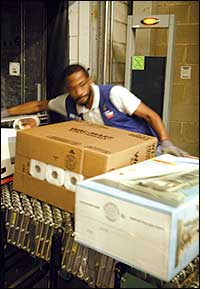As of mid-January, Wal-Mart was reading nearly 100 percent of the Electronic Product Codes on tagged pallets arriving at its distribution centers and stores. But Simon Langford, manager of Wal-Mart’s RFID strategy, admits that RFID is less than perfect at the case level. Wal-Mart is reading about 98 percent of the tagged cases traveling on conveyors in its distribution centers and on cases arriving at the backs of stores (where an appropriate tag is used). But it’s reading only about 60 percent of the cases stacked on pallets.
Some commentators suggest that this is a big problem, that business processes can’t be changed until read rates are at or near 100 percent. But Wal-Mart contends that the technology is more than good enough to enable it to improve its business processes. “I hear analysts say we’re only 98 percent accurate,” Langford says. “But that’s 98 percent better than we were [when goods weren’t identfied at all].”
|
|
Wal-Mart has also developed practical strategies and inventory software upgrades to cope with less-than-perfect read rates. If a store orders 20 Hewlett-Packard flat-bed scanners, only 18 tagged cases might be read when they arrive at the store, so 18 scanners (each case contains a single scanner) are added to the inventory database. When it’s time to replenish the shelves, Wal-Mart associates stack cases onto a cart and drive out to the sales floor. Since the cases stacked on the cart are in random orientation and are less densely packed than goods arriving on a truck, readers installed between the back room and the floor might pick up all 20 cases. The two cases not recorded upon their arrival are then added to the inventory.
But what if the readers, for whatever reason, pick up only 16 cases? Among the 16 may be the two that were not scanned at the back of the store. Wal-Mart knows the unique serial numbers on the tags of items that were shipped, so if they are read now, they’re added to the inventory. The retailer may record that 16 scanners are on the shelf when, in fact, 20 are, but that’s not a problem since the goal is to make sure that there is always product on the shelf.
Many products that arrive at the grocery side of a Supercenter come on a shrink-wrapped pallet. Wal-Mart reads the pallet tag and knows which cases are supposed to be on that pallet. But the store may read tags on only 20 of the 40 cases on the pallet. In that instance, those 20 cases are added to inventory. In the evening, Wal-Mart associates bring pallets onto the sales floor to replenish the shelves. Readers between the back room and the floor may read some additional cases on the pallet because the pallet’s orientation to the reader may be different as the pallet moves to the sales floor than it was when the pallet arrived at the back of the store.
“Since we can see the cases going out to the sales floor, I know I have 20-something cases going out to replenish the shelves,” says Langford. “That’s more than enough to fill the gaps on the shelf. We’ll bring the rest of the pallet back. Half the stock is gone, so I’m now able to read the EPCs on the [exposed] cases. That’s how you start to use the data intelligently.”
Langford says that when Wal-Mart started its pilot in the original seven Dallas-area stores, read rates were fairly low. But that’s because it was the first time the retailer and its suppliers were using the technology in the real world. And it was clear that for products that weren’t RF friendly, Wal-Mart and its suppliers had to work together to ensure that the appropriate types of tags were being used and placed on a case in an area where they could be read regardless of their orientation to the readers in Wal-Mart’s facilities.
“There were some good learnings there,” says Langford. “That’s how we got up to the high 90s, which is excellent, really. It’s given us the performance we need to change our approach.”


